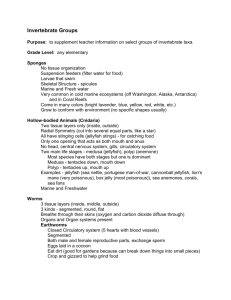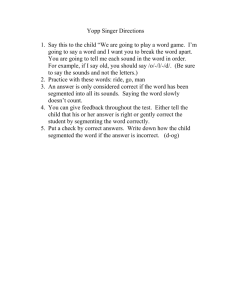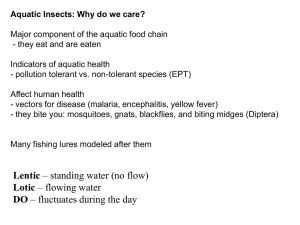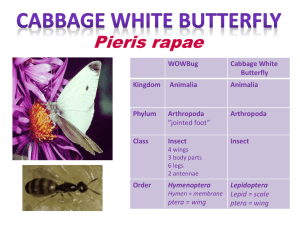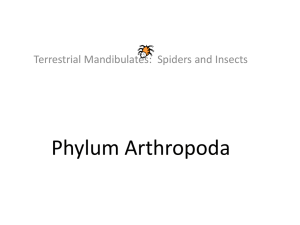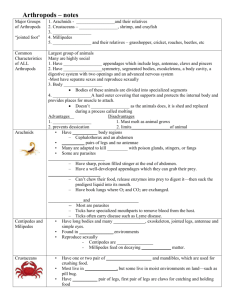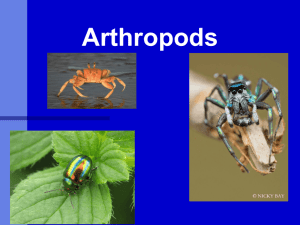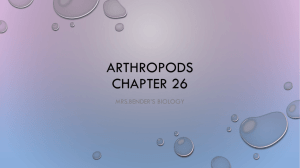Document 14841274
advertisement
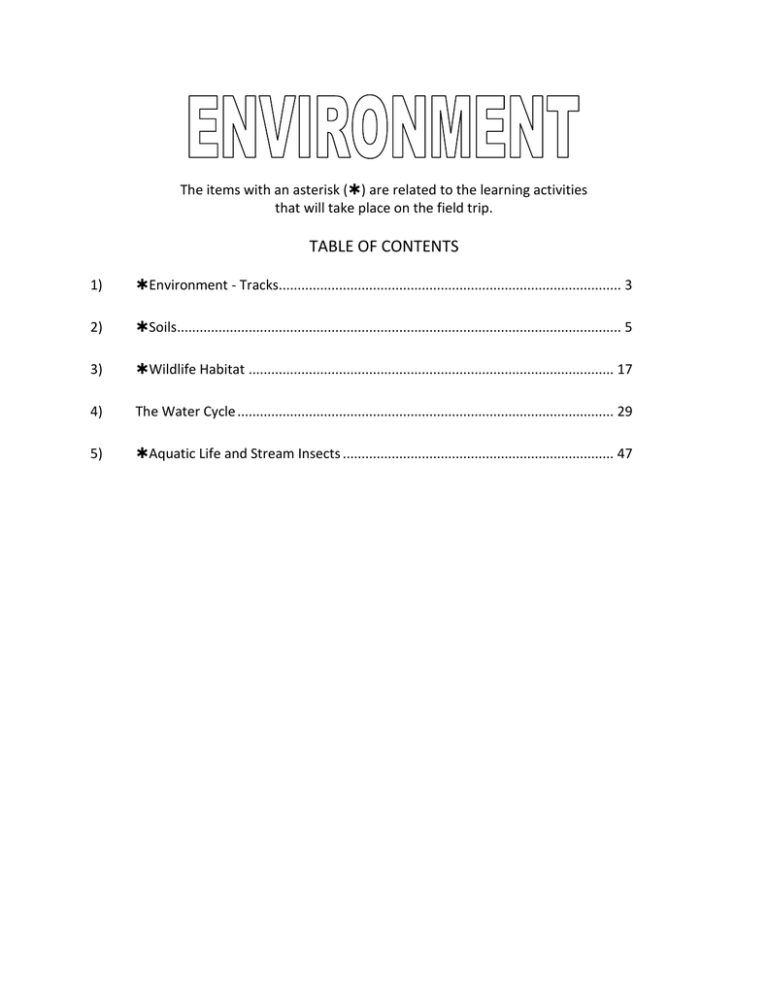
The items with an asterisk () are related to the learning activities that will take place on the field trip. TABLE OF CONTENTS 1) Environment - Tracks........................................................................................... 3 2) Soils...................................................................................................................... 5 3) Wildlife Habitat ................................................................................................. 17 4) The Water Cycle .................................................................................................... 29 5) Aquatic Life and Stream Insects ........................................................................ 47 [2] 1) ENVIRONMENT – TRACKS The students will be divided into four groups and will make 4 rotations to view the 4 stations of the Environmental track. The Environmental stations allow the students hands-on experience. The 4 stations are Soil, Who Polluted the Potomac River, Habitat Game and Water Quality. The Environment section shows children how best management practices affect water quality and the environment. Children get to learn about soils, water quality indicators, and the animals that live in the habitats provided by our local farms. Soil - There are several soil samples on display for the students to see and touch. See presentation. Who Polluted the Potomac River- This station encourages the children’s participation. The presenter uses a native script and prompts students when an event in the script causes the river to become more polluted. They fill vials with “river” water at each stage to show the changes in the water. Habitat Game-This relay game shows the 4 major requirements for survival in a habitat. Water Quality – This section is divided into 2 segments: Rainfall simulator and Insect display. The rainfall simulator provides a vivid demonstration of rainfall runoff results from different surfaces ranging from pavement to grass. The display for the insects has pictures and live bugs for the students to see to aid them in identifying these “good bugs.” [3] [4] 2) SOILS [5] [6] [7] [8] [9] [10] [11] [12] [13] [14] [15] [16] 3) WILDLIFE HABITAT [17] [18] [19] [20] [21] [22] [23] [24] [25] [26] [27] [28] 4) THE WATER CYCLE Source: http://www.kidzone.ws/water/ Run and get a glass of water and put it on the table next to you. Take a good long look at the water. Now -- can you guess how old it is? The water in your glass may have fallen from the sky as rain just last week, but the water itself has been around pretty much as long as the earth has! When the first fish crawled out of the ocean onto the land, your glass of water was part of that ocean. When the Brontosaurus walked through lakes feeding on plants, your glass of water was part of those lakes. When kings and princesses, knights and squires took a drink from their wells, your glass of water was part of those wells. And you thought your parents were OLD The earth has a limited amount of water. That water keeps going around and around and around and around and (well, you get the idea) in what we call the "Water Cycle". This cycle is made up of a few main parts: evaporation (and transpiration) condensation precipitation [29] collection Evaporation: Evaporation is when the sun heats up water in rivers or lakes or the ocean and turns it into vapor or steam. The water vapor or steam leaves the river, lake or ocean and goes into the air. Do plants sweat? Well, sort of.... people perspire (sweat) and plants transpire. Transpiration is the process by which plants lose water out of their leaves. Transpiration gives evaporation a bit of a hand in getting the water vapor back up into the air. Condensation: Water vapor in the air gets cold and changes back into liquid, forming clouds. This is called condensation. You can see the same sort of thing at home... pour a glass of cold water on a hot day and watch what happens. Water forms on the outside of the glass. That water didn't somehow leak through the glass! It actually came from the air. Water vapor in the warm air turns back into liquid when it touches the cold glass. [30] Precipitation: Precipitation occurs when so much water has condensed that the air cannot hold it anymore. The clouds get heavy and water falls back to the earth in the form of rain, hail, sleet or snow. Collection: When water falls back to earth as precipitation, it may fall back in the oceans, lakes or rivers or it may end up on land. When it ends up on land, it will either soak into the earth and become part of the “ground water” that plants and animals use to drink or it may run over the soil and collect in the oceans, lakes or rivers where the cycle starts all over again. [31] [32] [33] [34] Source: http://www.epa.gov/region1/students/pdfs/ww_disap.pdf [35] [36] [37] [38] [39] [40] [41] [42] [43] [44] [45] [46] 5) Aquatic Life and Stream Insects [47] [48] [49] [50] [51] [52] [53] [54] BIOLOGICAL INDICATORS OF WATERSHED HEALTH Source: http://www.epa.gov/bioindicators/html/dragonflies.html Information Source: McDonald, B., W. Borden, J. Lathrop.1990. Citizen Stream Monitoring: A Manual for Illinois. Illinois Department of Energy and Natural Resources, ILENR/RE-WR-90/18. Springfield, Illinois. Benthic Macroinvertebrates Sensitive Benthos Stoneflies Water Penny Beetles Mayflies Dobsonflies Alderflies Snipeflies Mussels Riffle Beetles Moderately Tolerant Benthos Damselflies Dragonflies Crayfish Amphipods Blackflies Caddisflies Isopods Craneflies Pollution Tolerant Benthos Midgeflies Worms Leeches Pouch Snails [55] [56] Source: http://people.virginia.edu/~sos-iwla/Stream-Study/Catalog/SensitiveTaxa.HTML Macroinvertebrates That Are Sensitive to Pollution Found in Good Quality Water Stonefly Riffle Beetle Adult Gilled Snail Planarian Mayfly Water Penny [57] CADDISFLY LARVA Facts Some make houses or cases for themselves out of different materials such as rocks, sand, gravel, twigs or leaves using a glue-like substance secreted from their back end Some spin webs to trap food from the flowing water One generation hatches per year Although most species are very sensitive to pollution, some are pollution tolerant Description Up to 1 1/2 inches long Very small or no antennae Six segmented legs on upper middle section of body Filamentous gills may be on the end of the body or on the underside Two small, thick extensions at the end of the body and each has a single hook at the end Words Found in Glossary antennae filament secreted segmented [58] CADDISFLY Source: http://bugguide.net/node/view/15740 [59] MAYFLY [60] Facts About 700 species in North America Develop in the stream during period of two weeks to two years Live on exposed rock surfaces in fast current or buried in soft stream beds Large numbers of flying adults may emerge from stream at the same time Description Plate like or feathery gills along the side of the abdomen Two or three long hair like tails Six segmented legs on middle section of body Each leg has one claw on the end The body can be up to one inch long Body is usually flat Words Found in Glossary abdomen plate like segmented species [61] [62] STONEFLY LARVA Facts About 500 species in North America Are found in cool, clean streams with high levels of dissolved oxygen Develop in the stream for period of three months to three years Are either predators or feed on fungi and bacteria from rotting leaves Description Two long antennae Two hair-like tails Gills often located on or behind each leg Six segmented legs on middle section of body Each leg has two hooks on the end [63] Words Found in Glossary larva (larvae) predator fungi bacteria antennae segmented species [64] Macroinvertebrates That Are Somewhat Sensitive to Pollution Found in Good or Fair Quality Water Crayfish Alderfly Crane Fly Riffle Beetle Larva Damselfly Sowbug Dragonfly Watersnipe Fly [65] Scud Whirligig Beetle Larva Fishfly Clam or Mussel [66] ALDERFLY LARVA Facts Carnivorous and may bite Develop over period of one to three years May be light colored Description Mouth has large, chewing pinchers Smooth underside without gill tufts Abdomen has strand-like appendages extending from each side Three pairs of segmented legs on middle section of body with tiny pinchers at the end of each Straight, single feathery tail [67] Words Found in Glossary abdomen appendages carnivorous gill tufts segmented [68] CRAYFISH Facts They grow by shedding ("molting") their shells Must hide while their new shell hardens to protect their soft bodies Often found hiding under rocks during the day and foraging on the stream bed during the night Females may be seen with eggs or young clinging to the underside of their abdomen Most live only two years, but some may live up to six or seven years Description Up to six inches long Eyes stand out from the body Two or four antennae Body covered with hard, plate like shell Ten legs, two of these are large claws Color is red, orange, brown or dark-colored [69] Words Found in Glossary abdomen antennae forage plate like [70] DAMSELFLY Facts Develop over one to four years Description Large eyes Large scoop-like lower lip No gills on the sides or underneath the abdomen Six long segmented legs on upper middle section of body Long spindly legs Narrow body with three oar-shaped tails (gills) that look like fans Words Found in Glossary abdomen gills larva (larvae) segmented [71] DAMSELFLY Source: http://bugguide.net/node/view/15740 [72] DRAGONFLY Facts Develop over one to four year period Description Large eyes Large scoop-like lower lip Wide oval or round abdomen that may end in three wedge-shaped extensions No gills on the sides or underneath Six long segmented legs on upper middle section of body [73] Words Found in Glossary abdomen gills larva (larvae) oval segmented wedge-shaped [74] Dragonflies Information Source: McDonald, B., W. Borden, J. Lathrop.1990. Citizen Stream Monitoring: A Manual for Illinois. Illinois Department of Energy and Natural Resources, ILENR/RE-WR-90/18. Springfield, Illinois. Metamorphosis: Incomplete (see our life cycle page for more information) Dragonfly Nymph Nymphs: vary in shape, but most have robust, elongated, or "spider-like" bodies, often with algae growing on their backs; six legs at side of body or near front on elongated species; two large eyes at sides of heads; a pair of small wings begins to develop on back; color varies from brown, black, but often green; length up to 2 inches Reproduction: Eggs are deposited on surface of water and drift to bottom. Adults: Similar to adult damselflies, but the two pairs of wings are flat or horizontal at rest; some species can attain lengths of over 4 inches. Food: Predaceous, nymphs feed upon other aquatic macroinvertebrates, small fish, and tadpoles. Scientific Name: Class: Insecta Order Odonata Suborder Anisoptera Indicator Role: Dragonflies are found in slower moving streams and in ponds, often reflecting waters with lower dissolved oxygen levels. [75] Adult Dragonfly Source: Free-Nature-Photos.org [76] FISHFLY Facts Carnivorous and may bite Develop during period of one to three years Description Mouth has large, chewing pinchers Retractable breathing tubes extend from top of abdomen (not visible without magnification) Smooth underside Abdominal segments with many strand-like appendages extending from each side Three pairs of legs on middle section of body with tiny pinchers at the end of each Back end is forked with two short tails and two hooks on each tail Light colored Often confused with hellgrammite (dobson fly larva) but does not have fluffy gills on underside Words Found in Glossary abdomen appendages carnivorous retractable segmented [77] Macroinvertebrates That Are Tolerant of Pollution Found in Any Quality Water Aquatic Worm Lunged Snail Black Fly Leech Midge Fly [78] Rainfall Simulator The rainfall simulator will relate different ground covers and farming methods to soil erosion and soil conservation. Good conservation practices are discussed. A stream is used to demonstrate and discuss water quality issues. Leachate from the different cover crops is collected and shown to the students. [79]
